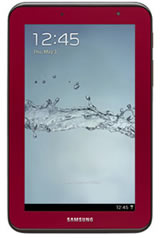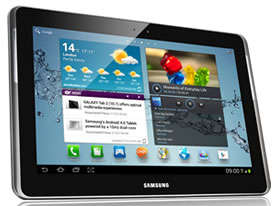Difference between Samsung Galaxy Tab 2 7.0 and Samsung Galaxy Tab 2 10.1
Key Difference: The Samsung Tab 2 7.0 is a 7-inch tablet that offers a PLS TFT LCD display, with approximately 170 ppi density. The device is also available in two versions; Wi-Fi only and Wi-Fi + 4G. The Wi-Fi only tablet is powered by a 1 GHz Dual-core processor and is available with the Android v4.0 Ice Cream Sandwich, while the Wi-Fi + 4G LTE tablet is powered by a 1.2 GHz Dual-core processor and comes with Android v4.1 Jelly Bean. The Galaxy Tab 2 10.1 is a 10.1-inch tablet that was launched in May 2012. The tablets sports a Plane Line Switching (PLS) TFT capacitive touchscreen with approximately 149 ppi density, making the resolution on the screen not that great. The Wi-Fi model is powered by 1 GHz Dual-core Cortex-A9, while the Wi-Fi + Mobile model is powered by 1.5GHz, Dual-core Krait Qualcomm processor.
 Samsung Galaxy Tab 2 7.0 is a major upgrade to the company’s original Samsung Galaxy Tab. The tab shares many features to its big brother The Galaxy Tab and the Galaxy Tab 7.0 Plus. The tab is actually a downgrade compared to the Galaxy 7.0 Plus, including the price of the tablet. However, during the launch it was also the only Tablet on the market at that time which served the Android Ice Cream Sandwich right out of the box. The device is also available in two versions; Wi-Fi only and Wi-Fi + 4G. Both the devices differ in a few areas so, when purchasing either device, make sure to once look over the various different features that are offered in the Wi-Fi + 4G, which are missing the Wi-Fi only model.
Samsung Galaxy Tab 2 7.0 is a major upgrade to the company’s original Samsung Galaxy Tab. The tab shares many features to its big brother The Galaxy Tab and the Galaxy Tab 7.0 Plus. The tab is actually a downgrade compared to the Galaxy 7.0 Plus, including the price of the tablet. However, during the launch it was also the only Tablet on the market at that time which served the Android Ice Cream Sandwich right out of the box. The device is also available in two versions; Wi-Fi only and Wi-Fi + 4G. Both the devices differ in a few areas so, when purchasing either device, make sure to once look over the various different features that are offered in the Wi-Fi + 4G, which are missing the Wi-Fi only model.
Both the models offer similar dimensions and major features, with the differences being only with the processor speed, OS, camera features and colors. The Samsung Tab 2 7.0 is a 7-inch tablet that offers a PLS TFT LCD display, with approximately 170 ppi density. The Plane to Line Switching (PLS) differs from the IPS technology of the other tablets and while it provides decent wide viewing angles, it still has a high propensity for reflecting surfaces. The display also lags compared to the other IPS displays with higher resolutions. The tablet is small and sleek compared to the other 7-inch devices making it lighter and easier to hold. The device has a sturdy design and has an all-grey plastic back. It has a thick bezel with a light grey screen. The device houses the power button, the volume button and the IR-port on the right side of the device, the microSD card slot is placed on the left side covered by a plastic flap. The 3.5mm jack is on top of the device and docking port is at the bottom.
The Wi-Fi only tablet is powered by a 1 GHz Dual-core processor and is available with the Android v4.0 Ice Cream Sandwich, while the Wi-Fi + 4G LTE tablet is powered by a 1.2 GHz Dual-core processor and comes with Android v4.1 Jelly Bean. Both devices offer 1 GB RAM and are available with 8/16/32 GB internal storage capacity that is expandable by 32 GB. The tablets house a 3.15 MP rear camera and a VGA front camera for video conferencing. The VGA camera is a downgrade from the 2 MP offered on Galaxy Tab 7.0 Plus. The camera also comes with a Flash that is placed under the camera on the back of the device. The 4 LTE tablets also come with additional camera features such as: Smile Shot, Geo-tagging, Editing Modes, Camcorder, DivX, HD Recording, HD Playback, Video Share and Online Image Uploading.
Both the devices sport IR blasters, which allow the tablet to be used as a fully-functioning remote control. The device houses a non-removable Lithium-ion 4,000 mAh that provides a lasts a good amount of time on the Wi-Fi as well as the 4G network. The device is available in black and white on the Wi-Fi + 4 LTE, while an additional Garnet Red color has been added to the line for the Wi-Fi only tablet. Both the models come with various built in Samsung Applications and have been approved for Enterprise by the Company, something known as SAFE (Samsung Approved for Enterprise). This includes an array of business applications such as: Microsoft® Exchange ActiveSync, Virtual Private Network (VPN) Access, Polaris® Office, Video Chat, Cisco WebEx, EAS IT Policy, HW Encryption and Sybase Afaria. However, it lacks in terms of tablet based applications in Google Play. Well, that is not exactly Samsung’s fault but it is one of things that have been keeping pushing sales of Apple tablets more than Android Tablets. Google Play has not been able to offer enough applications that support the tablet format. This problem should only be temporary as the demand for tablets is on the rise in the market.
 Following the launch of the Samsung Galaxy Tab 2 7.0, Samsung also needed a tablet for competing in the 10-inch tablet market. Lo and behold it launched the Samsung Galaxy Tab 2 10.1, which shares many similarities to its little brother. Similar to the Tab 2 7.0, the company launched two models of the Tab 2 10.1: Wi-Fi only and Wi-Fi + Mobile. The Wi-Fi and Wi-Fi + Mobile are quite identical in looks and also have similar hardware under the hood. The only differences between the two are the processor speed, OS and the camera features. The two different models allow the consumer to have the choice of either having only Wi-Fi or Wi-Fi + Mobile capabilities and pay accordingly.
Following the launch of the Samsung Galaxy Tab 2 7.0, Samsung also needed a tablet for competing in the 10-inch tablet market. Lo and behold it launched the Samsung Galaxy Tab 2 10.1, which shares many similarities to its little brother. Similar to the Tab 2 7.0, the company launched two models of the Tab 2 10.1: Wi-Fi only and Wi-Fi + Mobile. The Wi-Fi and Wi-Fi + Mobile are quite identical in looks and also have similar hardware under the hood. The only differences between the two are the processor speed, OS and the camera features. The two different models allow the consumer to have the choice of either having only Wi-Fi or Wi-Fi + Mobile capabilities and pay accordingly.
The Galaxy Tab 2 10.1 is a 10.1-inch tablet that was launched in May 2012. According to many review websites, the tablet has been a bit of a letdown compared to the original Tab 10.1. The company has completely shifted the focus of the tab and has even downgraded some of the features. To some it is worth the price, while the others are willing to shell out a little extra if the features are up to mark. The company has managed to keep the slim and sleek design of the device, which is one of the many good features of the Tab. The chassis is plastic and is available in brushed Titanium Grey, giving it a metal look. The speakers have been moved to the front of the screen and placed between the bezel and the chassis, making it seem like the tablet has ‘ears’. This also takes away from the fluidity of the bezel of the screen.
The tablets sports a Plane Line Switching (PLS) TFT capacitive touchscreen with approximately 149 ppi density, making the resolution on the screen not that great. The company has managed to put excellent viewing angles on the device but it still has a lot of reflective ability, making it harder to work under direct sunlight. The Wi-Fi model is powered by 1 GHz Dual-core Cortex-A9, while the Wi-Fi + Mobile model is powered by 1.5GHz, Dual-core Krait Qualcomm processor. Both the models offer 1 GB RAM. The device is a bit jerky in responding and is a little slow when switching between home screens. The Wi-Fi model comes with Android 4.0 Ice Cream Sandwich, while the Wi-Fi + Mobile comes with Android 4.1 Jelly Bean, but fear not the Wi-Fi model is upgradable to v4.1. Samsung has also added a screenshot button to the soft buttons at the bottom of the screen.
When in landscape mode, the device houses five features on the top of the device: a volume rocker, microSD slot, power/sleep button, an IR blaster, and a headphone jack. The camera sans flash resides on the back, while a dock connector and microphone pinhole are at the bottom of the device. The device offers a 3MP rear camera and a VGA camera for video calling. The rear camera offers decent images, though they images may be grainy when not taken in adequate lighting. The Wi-Fi model offers various camera features such as: Shot Modes
Effects, ISO, Scene mode, Shooting mode, White balance, Camcorder, HD Recording and
HD Playback. The device also has video taking capability. The tablet is available with 16/32 GB internal storage capacity that is upgradable by 32GB. The Galaxy Tab 2 10.1 houses a powerful non-removable Li-Po 7000 mAh battery, providing a good battery life compared to many other tablets. The device comes with already loaded Samsung apps, while other apps can be downloaded from the Google Play.
The information for the detailed table about the two phones has been taken from the Samsung website, pcmag.com, engadget.com, expertreviews.co.uk and GSMArena.com.
|
|
Samsung Galaxy Tab 2 7.0 |
Samsung Galaxy Tab 2 10.1 |
|
Launch Date |
April 2012 |
May 2012 |
|
Company |
Samsung |
Samsung |
|
Size |
193.7 x 122.4 x 10.5 mm |
256.6 x 175.3 x 9.7 mm |
|
Display |
7.0 in (18 cm) PLS TFT LCD display |
10.1-inch PLS TFT capacitive touchscreen |
|
Screen |
1024 × 600 pixels (~170 ppi pixel density) |
800 x 1280 pixels (~149 ppi pixel density) |
|
Protection |
N/A |
Corning Gorilla Glass |
|
Weight |
345 grams |
581 grams (Wi-Fi only) and 583 (Wi-Fi + Mobile) |
|
2G Network |
GSM 850 / 900 / 1800 / 1900 |
GSM 850 / 900 / 1800 / 1900 |
|
3G Network |
HSDPA 900 / 2100 - GT-P3100 HSDPA 850 / 900 / 1900 / 2100 - GT-P3105 |
HSDPA 850 / 900 / 1900 / 2100 |
|
4G Network |
Depends on market capability |
LTE Dual-band:17 and 4 |
|
GUI |
TouchWiz UX UI |
TouchWiz UX UI |
|
CPU speed |
1 GHz Dual-core processor/ 1.2 GHz Dual-core Qualcomm processor (4G) |
1 GHz Dual-core Cortex-A9 (Wi-Fi only)1.5GHz, Dual-core Krait, Qualcomm (Wi-Fi + Mobile) |
|
GPU |
PowerVR SGX540 |
PowerVR SGX540 |
|
OS |
Android OS v4.0.3 (Ice Cream Sandwich), upgradable to v4.1.1 (Jelly Bean) |
Android v4.0 (Wi-Fi) and Android v4.1 (Wi-Fi + Mobile) |
|
Chipset |
TI OMAP 4430 |
TI OMAP 4430 |
|
RAM |
1 GB RAM |
1 GB RAM |
|
SIM Size |
mini-SIM |
mini-SIM |
|
Internal Memory |
8/16/32 GB |
16/32 GB |
|
Expandable Memory |
Up to 32GB |
Upgradable to 32 GB |
|
Sensors |
Accelerometer, digital compass, light and proximity |
Accelerometer, light, compass |
|
Connectivity |
2G, 3G, 4G, Bluetooth technology v3.0, USB 2.0 Host, Wi-Fi 802.11 a/b/g/n, DLNA and Wi-Fi Direct |
EDGE, GPRS, LTE, Bluetooth, Wi-Fi and USB. |
|
Data |
GPRS, EDGE, WLAN, Bluetooth, USB |
GPRS, EDGE, WLAN, Bluetooth, USB, USB Host, Wi-Fi Hotspot. |
|
Speed |
HSPA+ 21Mbps 850/ 900/ 1900/ 2100 |
HSDPA, 21 Mbps; HSUPA, 5.76 Mbps |
|
WLAN |
Wi-Fi 802.11 a/b/g/n, DLNA, Wi-Fi Direct, dual-band, Wi-Fi hotspot |
Wi-Fi 802.11 a/b/g/n, Wi-Fi Direct, dual-band, Wi-Fi hotspot |
|
Bluetooth |
Bluetooth v3.0 with A2DP, HS |
Bluetooth v3.0 with A2DP |
|
USB |
USB v2.0, USB On-the-go |
USB v2.0, USB Host |
|
Primary Camera |
3.15 MP, 2048x1536 pixels |
3.15 MP |
|
Secondary Camera |
VGA |
VGA |
|
Video |
Full HD @30fps |
Full HD@30fps |
|
Camera Features |
|
|
|
Sound Enhancement |
SoundAlive |
SoundAlive |
|
Audio supported formats |
MP3, AAC, AC-3, AMR, FLAC, MID, WMA, WAV, OGG |
MP3, AAC/ AAC+/ EAAC+, WMA, OGG (vorbis), FLAC, AC-3 |
|
Video supported formats |
3GP, ASF, AVI, MP4, WMV, FLV, MKV, WebM |
3GP, AMR, H.263, H.264, MPEG4,QCIF |
|
Battery Capacity |
Non-removable Lithium-ion 4,000 mAh |
Non-removable Li-Po 7000 mAh battery |
|
Talktime |
2G: 40 hours 3G: 20 hours |
3G: 12 hours |
|
Standby Time |
2G: 1190 hours 3G: 1080 hours |
3G: 26 Days |
|
Available Colors |
Black, White, Red |
Titanium Silver, White |
|
Messaging |
SMS(threaded view), MMS, Email, Push Email, IM, RSS |
Email, Push Email, IM, RSS |
|
Browser |
HTML5, Adobe Flash |
HTML, Adobe Flash |
|
Radio |
No |
No |
|
GPS |
A-GPS support and GLONASS |
A-GPS with GLONASS |
|
Java |
Java via Java MIDP emulator |
Java via Java MIDP emulator |
|
Additional Features |
|
|
Images Courtesy: samsung.com









Add new comment